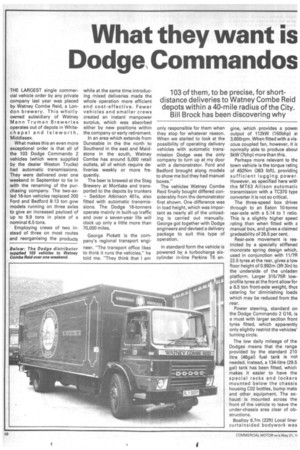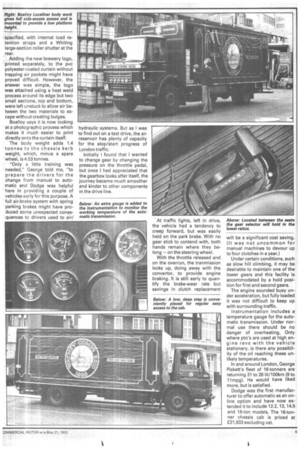What they want is
Page 64

Page 65

If you've noticed an error in this article please click here to report it so we can fix it.
Dodges Commandos 103 of them, to be precise, for shortdistance deliveries to Watney Combe Reid depots within a 40-mile radius of the City. Bill Brock has been discovering why
THE LARGEST single commercial vehicle order by any private company last year was placed by Watney Combe Reid, a London brewery. This wholly owned subsidiary of Watney Mann Truman Breweries operates out of depots in Whitechapel and Isleworth, Middlesex.
What makes this an even more exceptional order is that all of the 103 Dodge Commando 2 vehicles (which were supplied by the dealer Weston Trucks) had automatic transmissions. They were delivered over one weekend in September to tie in with the renaming of the purchasing company. The two-axled 16-ton vehicles replaced 200 Ford and Bedford 8-13 ton gvw models running on three axles to give an increased payload of up to 9.9 tons in place of a nominal 6.5 tons.
Employing crews of two instead of three on most routes and reorganising the products while at the same time introducing mixed deliveries made the whole operation more efficient and cost-effective. Fewer vehicles and smaller crews created an instant manpower surplus, which was absorbed either by new positions within the company or early retirement.
In an area which extends from Dunstable in the the north to Southend in the east and Maidstone in the south, Watney Combe has around 5,000 retail outlets, all of which require deliveries weekly or more frequently.
The beer is brewed at the Stag Brewery at Mortlake and transported to the depots by trunkers — Seddon Atkinson 401s, also fitted with automatic transmissions. The Dodge 16-tonners operate mainly in built-up traffic and over a seven-year life will clock up only a little more than 70,000 miles.
George Pickett is the company's regional transport engi neer. "The transport office likes to think it runs the vehicles," he told me. "They think that I am only responsible for them when they stop for whatever reason. When we started to look at the possibility of operating delivery vehicles with automatic transmission Dodge was the only company to turn up at my door with a demonstrator. Ford and Bedford brought along models to show me but they had manuel boxes."
The vehicles Watney Combe Reid finally bought differed considerably from the demonstrator first shown. One difference was in load height, which was important as nearly all of the unloading is carried out manually. George got together with Dodge engineers and devised a delivery package to suit this type of operation.
In standard form the vehicle is powered by a turbocharge sixcylinder in-line Perkins T6 en gine, which provides a power output of 112kW (150bhp) al 3,600rpm. When fitted with a viscous coupled fan, however, it is normally able to produce aboul 5kW (7bhp) more than this.
Perhaps more relevant to the town vehicle is the torque rating of 492Nm (363 lbft), providing sufficient lugging power. However, as specified here with the MT63 Allison automatic transmission with a TC370 type converter it is not so critical.
The three-speed box drives through to an Eaton 10-tonne rear-axle with a 5.14 to 1 ratio. This is a slightly higher speed rating than when fitted with a manual box, and gives a claimed gradeability of 26.5 per cent.
Rear-axle movement is restricted by a specially stiffened monorate spring design which, used in conjunction with 11/7R 22.5 tyres at the rear, gives a low floor height of 0.992m (3ft 3in) to the underside of the unladen platform. Larger 315/75R lowprofile tyres at the front allow for a 6.5 ton front-axle weight, thus catering for diminishing loads which may be reduced from the .rear.
Power steering, standard on the Dodge Commando 2 G16, is a must with larger section front tyres fitted, which apparently only slightly restrict the vehicles' turning circle.
The low daily mileage of the Dodges means that the range provided by the standard 210 litre (46ga1) fuel tank is not needed. Instead, a 134-litre (29.5 gal) tank has been fitted, which makes it easier to have the special racks and lockers mounted below the chassis housing CO2 bottles, bump mats and other equipment. The exhaust is mounted across the front of the vehicle to leave the under-chassis area clear of obstructions. specified, with internal load retention straps and a Whiting large-section roller shutter at the rear.
Adding the new brewery logo, printed separately, to the pvc polyester-coated curtain without
trapping air pockets might have proved difficult. However, the
answer was simple, the logo
was attached using a heat weld process around its edge but two small sections, top and bottom, were left unstuck to allow air between the two materials to escape without creating bulges.
Boalloy says it is now looking at a photographic process which makes it much easier to print directly onto the curtain itself.
The body weight adds 1.4 tonnes to the chassis kerb weight, which, minus a spare wheel, is 4.53 tonnes.
"Only a little training was needed," George told me, "to
prepare the drivers for the change from manual to automatic and Dodge was helpful here in providing a couple of vehicles early for this purpose. A full air-brake system with spring
parking brakes might have produced some unexpected consequences to drivers used to air/
hydraulic systems. But as I was to find out on a test drive, the air reservoir has plenty of capacity for the stop/start progress of London traffic.
Initially I found that I wanted to change gear by changing the pressure on the throttle pedal, but once I had appreciated that the gearbox looks after itself, the journey became much smoother and kinder to other components in the drive line.
At traffic lights, left in drive, the vehicle had a tendency to creep forward, but was easily held on the park brake. With no gear stick to contend with, both hands remain where they belong — on the steering wheel.
With the throttle released and on the overrun, the tranmission locks up, doing away with the convertor, to provide engine braking. It is still early to quantify the brake-wear rate but savings in clutch replacement will be a significant cost saving. (It was not uncommon for manual machines to devour up to four clutches in a year.) Under certain conditions, such as slow hill climbing, it may be desirable to maintain one of the lower gears and this facility is accommodated by a hold position for first and second gears.
The engine sounded busy under acceleration, but fully loaded it was not difficult to keep up with surrounding traffic.
Instrumentation includes a temperature gauge for the automatic transmission. Under normal use there should be no danger of overheating. Only where pto's are used at high engine revs with the vehicle stationary, is there any possibility of the oil reaching these unlikely temperatures.
In and around London, George Pickett's fleet of 16-tonners are returning 31 to 26 lit/100km (9 to 11mpg). He would have liked more, but is satisfied.
Dodge was the first manufacturer to offer automatic as an online option and have now extended it to include 12.2, 13, 14.5 and 16-ton models. The 16-tonner chassis cab is priced at £21,933 excluding vat.
























































































































